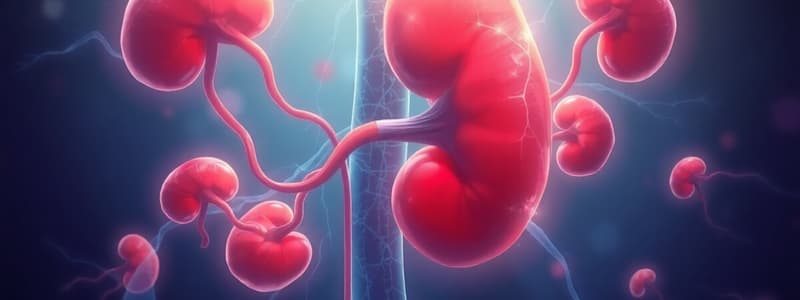Podcast
Questions and Answers
What is a hallmark characteristic of nephrotic syndrome?
What is a hallmark characteristic of nephrotic syndrome?
- Hypertension
- Proteinuria greater than 3.5 g/day (correct)
- Hematuria
- Increased serum creatinine
Which of the following symptoms is primarily associated with nephritic syndrome?
Which of the following symptoms is primarily associated with nephritic syndrome?
- Hyperlipidemia
- Hypoalbuminemia
- Severe edema
- Hematuria with dysmorphic RBCs (correct)
What is commonly observed in patients with nephrotic syndrome due to low albumin levels?
What is commonly observed in patients with nephrotic syndrome due to low albumin levels?
- Microscopic hematuria
- Increased GFR
- Hyperlipidemia (correct)
- Renal impairment
Which of the following features is least likely present in nephrotic syndrome?
Which of the following features is least likely present in nephrotic syndrome?
What primary condition is characterized by hypoalbuminemia and significant edema?
What primary condition is characterized by hypoalbuminemia and significant edema?
In nephritic syndrome, what typically happens to the glomerular filtration rate (GFR)?
In nephritic syndrome, what typically happens to the glomerular filtration rate (GFR)?
Which of the following is NOT a common cause of nephrotic syndrome?
Which of the following is NOT a common cause of nephrotic syndrome?
Which symptom is a common feature of nephritic syndrome but not nephrotic syndrome?
Which symptom is a common feature of nephritic syndrome but not nephrotic syndrome?
How does hypertension typically present in nephrotic syndrome compared to nephritic syndrome?
How does hypertension typically present in nephrotic syndrome compared to nephritic syndrome?
Flashcards are hidden until you start studying
Study Notes
Nephrotic Syndrome
- Characterized by severe proteinuria, exceeding 3.5 g/day
- Hypoalbuminemia due to protein loss in urine, causing edema (periorbital in morning, lower extremities later in the day)
- Hyperlipidemia as a compensatory response to low albumin, liver increases lipoprotein synthesis
- May have lipiduria (fatty casts or oval fat bodies in the urine)
- Common causes: Minimal change disease, focal segmental glomerulosclerosis (FSGS), membranous nephropathy
Nephritic Syndrome
- Hematuria, often microscopic but can be gross, with dysmorphic red blood cells (RBCs) or RBC casts, indicating glomerular bleeding
- Hypertension due to salt and water retention
- Renal impairment with increased serum creatinine and decreased glomerular filtration rate (GFR)
- Moderate proteinuria, less severe than nephrotic syndrome
- Possible oliguria (low urine output) and mild edema
Key Differences
- Nephrotic Syndrome: Severe proteinuria, hypoalbuminemia, edema, minimal hematuria, no or mild hypertension
- Nephritic Syndrome: Hematuria, hypertension, renal impairment, moderate proteinuria
Studying That Suits You
Use AI to generate personalized quizzes and flashcards to suit your learning preferences.



